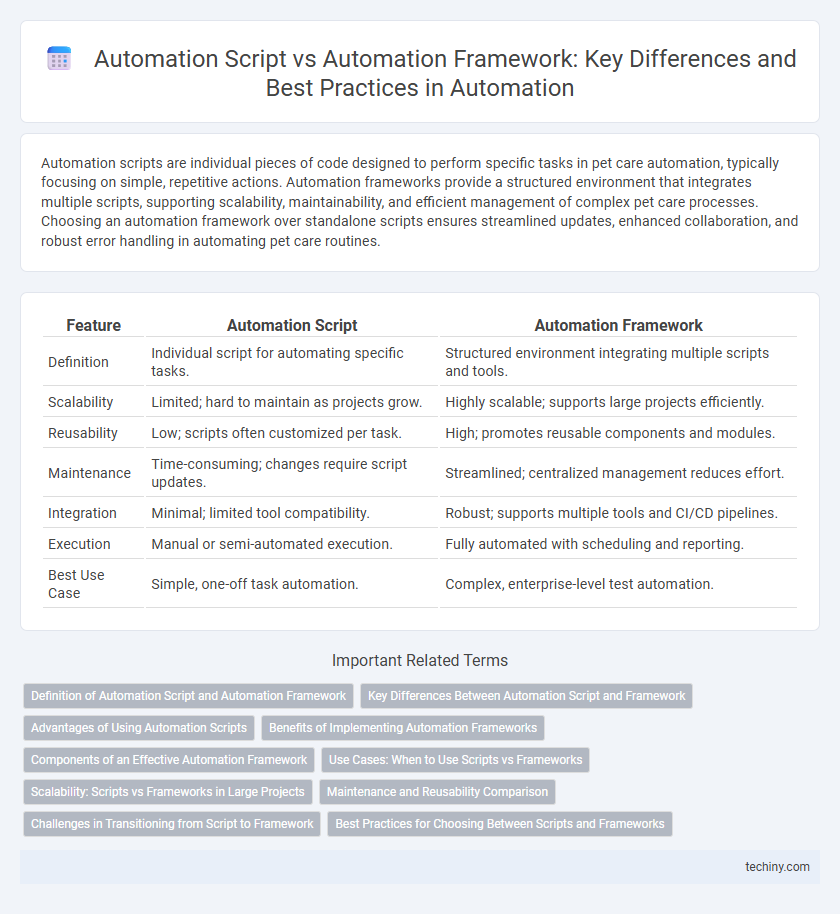Automation scripts are individual pieces of code designed to perform specific tasks in pet care automation, typically focusing on simple, repetitive actions. Automation frameworks provide a structured environment that integrates multiple scripts, supporting scalability, maintainability, and efficient management of complex pet care processes. Choosing an automation framework over standalone scripts ensures streamlined updates, enhanced collaboration, and robust error handling in automating pet care routines.
Table of Comparison
| Feature | Automation Script | Automation Framework |
|---|---|---|
| Definition | Individual script for automating specific tasks. | Structured environment integrating multiple scripts and tools. |
| Scalability | Limited; hard to maintain as projects grow. | Highly scalable; supports large projects efficiently. |
| Reusability | Low; scripts often customized per task. | High; promotes reusable components and modules. |
| Maintenance | Time-consuming; changes require script updates. | Streamlined; centralized management reduces effort. |
| Integration | Minimal; limited tool compatibility. | Robust; supports multiple tools and CI/CD pipelines. |
| Execution | Manual or semi-automated execution. | Fully automated with scheduling and reporting. |
| Best Use Case | Simple, one-off task automation. | Complex, enterprise-level test automation. |
Definition of Automation Script and Automation Framework
An automation script is a set of coded instructions designed to execute specific tasks or tests automatically, often targeting a particular function or feature. An automation framework, by contrast, is a comprehensive structure that integrates multiple automation scripts, standardized processes, tools, and best practices to facilitate scalable and maintainable automated testing or operations. The framework supports script development, execution, reporting, and maintenance, enhancing efficiency and consistency across automation efforts.
Key Differences Between Automation Script and Framework
Automation scripts are individual, standalone pieces of code designed to perform specific tasks, while automation frameworks provide a structured environment with guidelines, tools, and libraries to support multiple scripts and promote reusability. Frameworks enhance maintainability, scalability, and consistency by integrating components like test data management, reporting, and logging, whereas scripts typically lack these features. The adoption of frameworks results in more efficient test automation cycles and better collaboration across teams compared to isolated automation scripts.
Advantages of Using Automation Scripts
Automation scripts offer rapid development and easy customization for specific testing needs, enabling quick identification of defects with minimal setup. They require less initial investment compared to full automation frameworks, making them ideal for small projects or focused tasks. The simplicity and flexibility of scripts allow testers to quickly modify or extend tests without extensive training or infrastructure changes.
Benefits of Implementing Automation Frameworks
Automation frameworks enhance test accuracy and consistency by providing predefined guidelines and reusable components, reducing human error and minimizing maintenance efforts. They enable parallel test execution and integration with CI/CD pipelines, accelerating development cycles and improving software quality. Implementing automation frameworks promotes scalability and collaboration among teams through standardized processes and centralized test management.
Components of an Effective Automation Framework
An effective automation framework integrates reusable automation scripts, libraries, and test data management components to streamline the testing process. Key components include a test execution engine, result reporting modules, logging mechanisms, and configuration management tools that ensure consistency and scalability. Robust frameworks also support parameterization, exception handling, and modularity to enhance maintainability and adaptability across diverse testing scenarios.
Use Cases: When to Use Scripts vs Frameworks
Automation scripts are ideal for simple, repetitive tasks or one-time processes such as data extraction, basic UI interactions, or quick validations where speed and minimal setup are priorities. Automation frameworks suit complex, large-scale projects involving multiple test cases, integration with CI/CD pipelines, and requiring maintainability, scalability, and reusable components. Choosing between scripts and frameworks depends on project scope, team collaboration needs, and long-term maintenance considerations.
Scalability: Scripts vs Frameworks in Large Projects
Automation frameworks offer superior scalability compared to automation scripts by providing reusable components, standardized guidelines, and modular structures that support complex workflows in large projects. Scripts tend to become difficult to maintain and scale as project size increases, often leading to redundancy and increased error rates. Frameworks enable better collaboration, streamlined test management, and easier integration with CI/CD pipelines, making them essential for scalable automation in enterprise environments.
Maintenance and Reusability Comparison
Automation frameworks offer superior maintenance and reusability compared to individual automation scripts by providing structured environments with standardized libraries, modular components, and clear guidelines. Scripts often require significant updates for each change, while frameworks enable easier adaptation and scalability through reusable modules and centralized control points. This results in reduced maintenance efforts and enhanced efficiency in evolving test processes within automation projects.
Challenges in Transitioning from Script to Framework
Transitioning from an automation script to an automation framework involves challenges such as scaling test maintenance, managing reusable components, and ensuring consistent reporting across various environments. Scripts often lack modularity, making it difficult to integrate new features or adapt to dynamic application changes without significant rewrites. Implementing a robust framework requires addressing these limitations by adopting structured design patterns and standardized processes for better scalability and stability.
Best Practices for Choosing Between Scripts and Frameworks
Automation scripts offer quick, task-specific solutions ideal for simple, repetitive processes, while automation frameworks provide scalable, maintainable environments designed for complex, large-scale testing and development. Best practices for choosing between them involve assessing project complexity, team expertise, and long-term maintenance needs, ensuring the selected approach aligns with desired scalability and integration capabilities. Prioritizing modularity, reusability, and ease of debugging supports efficient automation tailored to both immediate tasks and evolving requirements.
Automation Script vs Automation Framework Infographic

 techiny.com
techiny.com